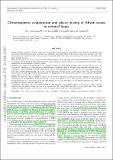Chromospheric evaporation and phase mixing of Alfvén waves in coronal loops
Abstract
Context. Phase mixing of Alfvén waves has been studied extensively as a possible coronal heating mechanism but without the full thermodynamic consequences considered self-consistently. It has been argued that in some cases, the thermodynamic feedback of the heating could substantially affect the transverse density gradient and even inhibit the phase mixing process. Aims. In this paper, for the first time, we use magnetohydrodynamic (MHD) simulations with the appropriate thermodynamical terms included to quantify the evaporation following heating by phase mixing of Alfvén waves in a coronal loop and the effect of this evaporation on the transverse density profile. Methods. The numerical simulations were performed using the Lagrangian Remap code Lare2D. We set up a 2D loop model consisting of a field-aligned thermodynamic equilibrium and a cross-field (background) heating profile. A continuous, sinusoidal, high-frequency Alfvén wave driver was implemented. As the Alfvén waves propagate along the field, they undergo phase mixing due to the cross-field density gradient in the coronal part of the loop. We investigated the presence of field-aligned flows, heating from the dissipation of the phase-mixed Alfvén waves, and the subsequent evaporation from the lower atmosphere. Results. We find that phase mixing of Alfvén waves leads to modest heating in the shell regions of the loop and evaporation of chromospheric material into the corona with upflows of the order of only 5–20 m s−1. Although the evaporation leads to a mass increase in the shell regions of the loop, the effect on the density gradient and, hence, on the phase mixing process, is insignificant. Conclusions. This paper self-consistently investigates the effect of chromospheric evaporation on the cross-field density gradient and the phase mixing process in a coronal loop. We found that the effects in our particular setup (small amplitude, high frequency waves) are too small to significantly change the density gradient.
Citation
Van Damme , H J , De Moortel , I , Pagano , P & Johnston , C D 2020 , ' Chromospheric evaporation and phase mixing of Alfvén waves in coronal loops ' , Astronomy & Astrophysics , vol. 635 , A174 . https://doi.org/10.1051/0004-6361/201937266
Publication
Astronomy & Astrophysics
Status
Peer reviewed
ISSN
0004-6361Type
Journal article
Description
This work has received support from the UK Science and Technology Facilities Council (Consolidated Grant ST/K000950/1), the European Union Horizon 2020 research and innovation programme (grant agreement No. 647214) and the Research Council of Norway through its Centres of Excellence scheme, project number 262622.Collections
Items in the St Andrews Research Repository are protected by copyright, with all rights reserved, unless otherwise indicated.

